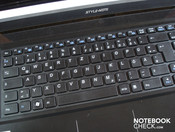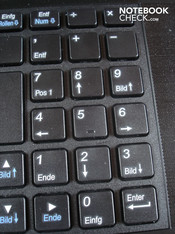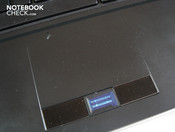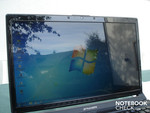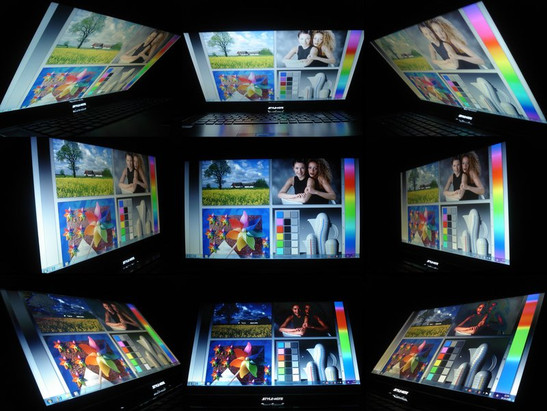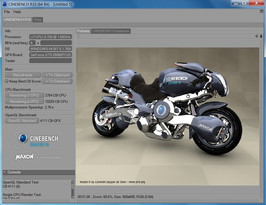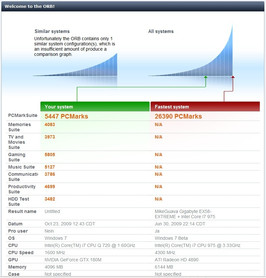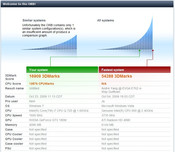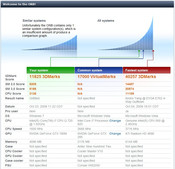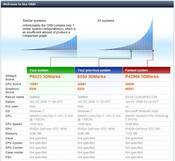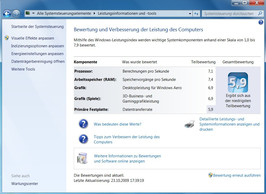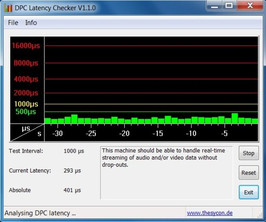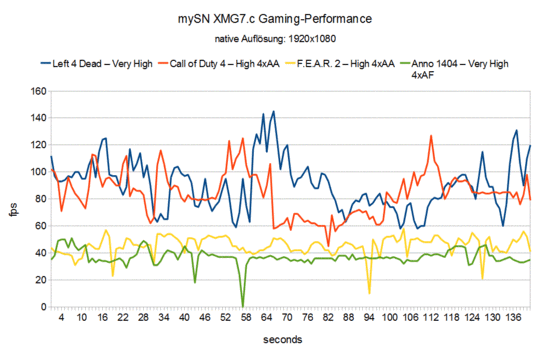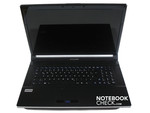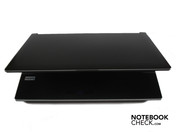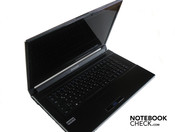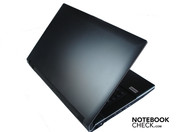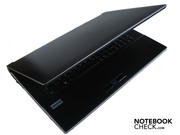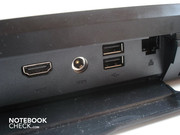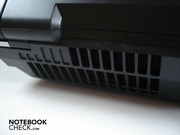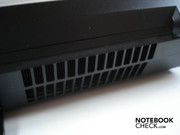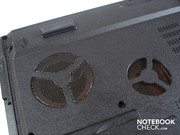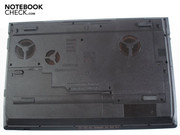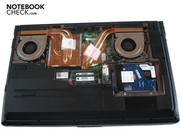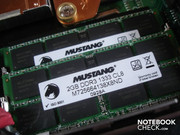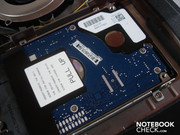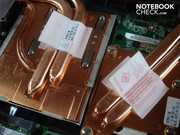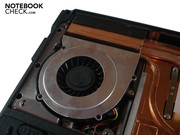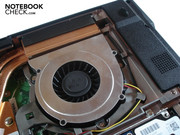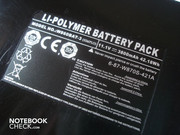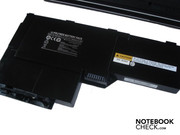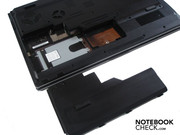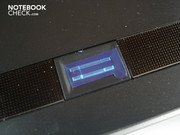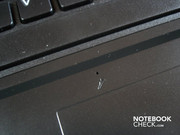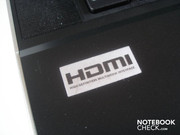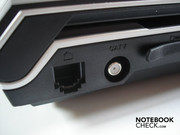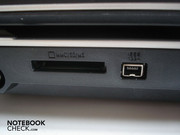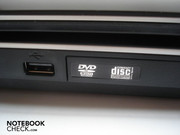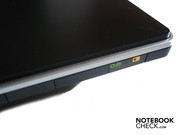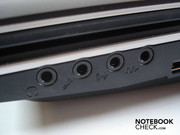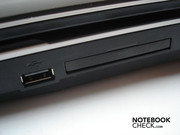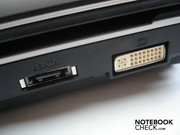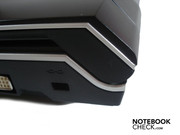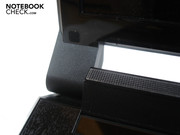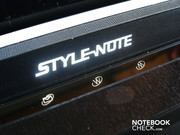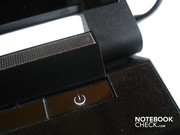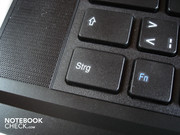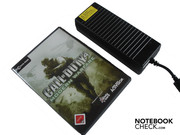Review mySN XMG7.c Notebook
The power of Core i7.
The mySN XMG7.c, based on Clevo's W870CU barebone, doesn't only represent a notebook of the upper class in view of price. Thanks to the brand new Intel Core i7-720M and the Nvidia GeForce GTX 280M, the 17.3 inch notebook also provides for baffled faces under its hood. We've scrutinized the mySN XMG7.c and clarified the question: What does the high-end notebook have to offer apart from its alleged brute performance.
The mySN XMG7.c can be individually configured in almost all things. An Intel Core i7 is employed as the CPU, whereas there are three different alternatives to choose from. Starting with the i7-720QM that clocks with 1.60 up to 2.80 GHz (automatic overclocking, 6 MByte L3 cache, 45W TDP) and is already included in the basic configuration for 1679 Euros. Those who have a bit more money in their pocket should take the i7-820QM (1,73 to 3,06 GHz, 8 MByte L3-Cache, 45W TDP) for a surcharge of 170 Euros or the i7-920XM (2,0 to 3,2 GHz, 8 MByte L3-Cache, 55W TDP) for a dizzying surcharge of 603 Euros.
In any case, a GeForce GTX 280M with one GByte GDDR3 VRAM is built-in as the graphic card, an SLI option isn't available. The system memory is large enough for two up to eight GByte DDR3 RAM with 1333 MHz each. Additionally, up to two hard disks fit into the case of the mySN XMG7.c. Either SSDs with a maximum capacity of 250 GBytes or HDDs with a maximum capacity of 500 GBytes. The customer can chose among a normal DVD burner and a BluRay drive (plus 120 Euros) or a BluRay burner (plus 285 Euros).
Apart from that, an optional TV card (plus 130 Euros), as well as a WLAN module (Intel 5300AGN, plus 40 Euro) can be built-in. N.B.: An operating system isn't included in the basic configuration. If you like, you can order Windows Vista or the just released Windows 7 (in various versions, 32 or 64 bit) right away.
The basic warranty of the XMG7.c amounts to 24 months (Pick-Up&Return, 6 months instant repair, Germany). If you want to play it safe, you should extend the warranty to 36 months (including 12 months instant repair Germany) for a surcharge of 140 Euros or even to 48 months (including 24 months instant repair, Germany) for a steep 280 Euros.
Case
As mentioned in the beginning, the mySN XMG7.c's case is based on Clevo's W870CU barebone. The massive case can't really be called mobile due to its size of 412 x 279 x 48 mm (breadth x depth x height) and its weight of 3950 grams. In return, the design is very impressive. The clear line management and the matt black surface (according to the manufacturer Titanium Gray, but it's also available in silver) is stylish and timeless at the same time and therefore fits into every surrounding. Additionally, the surface isn't very prone to smudge and other outer influences (such as fingerprints) leaves it cold, too.
The material is mainly plastic but this isn't noticeable even when looking closer, giving the case a very high-end impression. The stability of the upper side and the bottom is exemplary. We couldn't get the XMG7.c to yield obviously even under stronger pressure. The display lid doesn't do as well here. The lid can be depressed quite strongly in its center and the area between the hinges also twists evidently under pressure. In opposition, image distortions can only be provoked by touching the display frame firmly.
Both hinges have been placed on the case's outermost edge and do their job stably and reliably. Due to its heavy weight, the case doesn't pivot at opening. Finally, the workmanship is excellent. Everything is rock solid, nothing wobbles and all edges have been manufactured cleanly.
Equipment
Connectivity
Of course, an adequate amount of connections and interfaces shouldn't be omitted in such a high-priced notebook. The prototype scores on the wireless field with WLAN (Intel Wireless WiFi Link 5300 AGN) and Bluetooth. Further connections to a network or internet can also be built up over an RJ-45 Gigabit LAN (rear) and an RJ 11 modem (left).
The socket for the adapter, two USB 2.0 ports straight off and an HDMI-out for connecting external monitors have been placed on the back (behind a somewhat cheap-looking cover). On the left an antenna socket, a 7-in-1 cardreader, Firewire, an USB 2.0 port and the DVD burner follow. There is only a lonely infrared receiver on the front. And finally, the right side has four audio sockets (line-in, microphone-in, headphone-out, S/PDIF digital-out), a further USB 2.0 port (adding up to a total of four), a 54mm ExpressCard slot, an eSATA, DVI, and a Kensington lock.
Apart from this, the XMG7.c also has a fingerprint scanner (between the touchpad keys), an integrated microphone and a two megapixel webcam. We found the interface distribution generally good. Gamers connect the most vital cables, mains, network, a mouse and eventually a keyboard, to the rear right away. Merely the audio sockets have been placed a bit too far front for our taste. Because the audio connections have been kept in the same color, the differentiation is an redundant difficulty.
Software
Whilst the majority of manufacturers like to virtually stuff the Windows installation with dozens of unnecessary programs, Shenker is rather more modest and restricts itself to the most important ones. Thus, we only found 13 programs and drivers in the deinstallation routine. In this regard, other manufacturers end up easily with 50 to 70 programs. The positive effect of such a slight installation expresses itself in an agreeably fast boot procedure and a high work speed and that even shortly after loading Windows 7.
Input Devices
Keyboard
We especially liked the keyboard's pinpoint pressure point. This isn't only because the keyboard barely deflects under even stronger pressure. The key noise is sometimes a bit clattery, but this barely bothered us, though. The key size is just still alright, we would have liked to have them a bit bigger. The keyboard can be cleaned quite easily because the space between the single keys has turned out fairly large due to their size.
Moreover, the layout doesn't give reason for complaint because all keys sit subjectively tight and in the right place. Naturally, there is also place for a separate numerical block in such an opulent case. Various functions can be controlled with the integrated Fn key (right of the left Crtl key), as usual. Almost everything is given - from brightness and volume control up to enabling and disabling the WLAN/Bluetooth and touchpad.
Over the keyboard and underneath the lighted "Style-Note" logo, there is a small touch sensitive bar with three function fields, for starting the web browser among other things.
Touchpad
Contrarily to the keyboard we weren't quite as convinced by the touchpad that has been kept in the same color as the case, and its correlating keys. The touchpad has an adequate size and has proper gliding traits due to the fairly smooth surface, but it sometimes appeared to be a bit indistinct and imprecise in its handling. Furthermore, we couldn't accommodate ourselves to the integrated scroll function even after a longer period, because this often aborted, slid in the wrong direction or simply wasn't triggered.
Both touchpad keys couldn't gain any ground here. The pressure point proved to be very indistinct. The acoustic triggering feedback can also be described as insufficient.
Display
The mySN XMG7.c's 17.3 inch display has an LED backlight, is in a 16:9 format and impresses with a FullHD resolution of 1920x1080 pixels. Above that, the reflective display's results are very impressive. Whilst the luminosity turn out sufficient to good with an average of 194.2 cd/m2 and illumination of 78%, the other results play out their trump.
The very good black value of 0.22 cd/m2 as well as the excellent contrast of 968:1 is flabbergasting. Subjectively, the intense and true-to-life colors were very pleasing. Because the display is usually one of the biggest weak points in most notebooks, we were more than just pleasantly surprised.
| |||||||||||||||||||||||||
Brightness Distribution: 78 %
Center on Battery: 213 cd/m²
Contrast: 968:1 (Black: 0.22 cd/m²)
Just too bad that Clevo has equipped the display with a reflective coating because no matter how good the image quality is, the user doesn't see much of it outdoors due to the intense reflections. However, because the brightness isn't reduced in battery mode, at least an occasional stay outdoors is possible.
Performance
Schenker only uses upper class products for the components. Nvidia's currently fastest mobile single-chip graphic card, the GeForce GTX 280M, is used as a graphic card. The GeForce 280M is based on the G92b core and is therefore comparable with the GeForce 9800 GTX+ desktop. Furthermore, the GeForce GTX 289M, manufactured in a structure width of 55nm, has 128 stream processors, one GByte GDDR3 VRAM and clocks with 583 MHz (core), 950 MHz (memory), and 1450 MHz (shader). Due to the high power consumption of up to 75 Watts, the GeForce GTX 280M is only suitable for large notebooks of the 17 - 18 inch range.
Fitting to the high-end demand, Schenker supports the GeForce GTX 280M with an efficient quad-core CPU. The employed 720QM originates from Intel's brand new, mobile Core i7 range and boasts with all sorts of state-of-the-art features. Thus, the four included cores act like eight cores due to hyper-threading (can be seen in the task manager). The performance difference of four simulated additional cores carries barely any weight for games; the velocity of optimized applications can be given a significant boost through this technology.
The biggest bonus of the processor manufactured in 45nm is probably its automatic overclocking. The standard clock rate of 1.60 GHz can be increased up to 2.80 GHz when required and with a sufficient cooling. This guaranties that the energy requirement is kept within a limit (45 Watt TDP maximum) on the one hand and on the other, games have the necessary computing power available due to overclocking. In opposition to the "old" Core 2 Quad, the Core i7-720QM doesn't only serve with an L2 but also with an L3 cache. This adds up to six MBytes in the i7-720QM.
Moreover, a four GByte DDR3 RAM that runs with 1333 MHz are busy in the XMG7.c's case. Because the 64 bit version of Windows 7 Home Premium is applied as the operating system, the entire memory capacity is available.
Let's now look at our benchmark course and start with the CPU-biased benchmarks. The Core i7-720QM felt at home in Cinebench R10 and shone with TOP results. Whilst the CPU reached a very good 3701 points in single-core rendering, it was even an enormous 102299 points in multi-core rendering. In comparison: A Core 2 Quad Q9000 with 2.00 GHz (six MByte L2 cache, equally 45 watt TDP) is significantly slower with 2468 points in single-core and 7893 points in multi-core rendering. PCMark Vantage shows a similar picture. The Core i7-720QM obviously exceeds the Core 2 Quad Q9000 with 5447 to 4634 points.
We chose the Radeon HD 4850 for comparison of the GPU-biased benchmarks. The Radeon HD 4850 is rather more on a level with the GeForce GTX 260M, but because the HD 4870 (the actual competitor card of the built-in GeForce GTX 280M) is barely used, we didn't have any other choice but to use the Radeon HD 4850.
The graphic cards were surprisingly very close to each other with 16909 points (GeForce GTX 280M) and 16496 points (Radeon HD 4850) in 3DMark 05. The situation looks different in 3DMark06, though. The GeForce GTX 280M (11825 points) exceeds the Radeon HD 4850 (9784 points) noticeably. The difference is similarly extreme in the 3DMark Vantage. Whilst the Radeon HD 4850 manages 5500 points, the GeForce GTX 280M achieves an impressive 6023 points (without PhysX).
The velocity of the hard disk(s) shouldn't be ignored, either. Our prototype has two Seagate disks with a capacity of 320 GBytes. The results were established with the HDTune tool, whereas it should be afore mentioned that both hard disks have about the same performance range.
Thus, the average transfer rate was an excellent 74.6 - 75.1 MB/s (minimum 47.1 - 48.2 MB/s, maximum 92.6 - 94.2 MB/s). The access rates turns out, in opposition to that, rather average with 16.8 - 17.0 ms and a throughput rate of 56.7 - 56.8 MB/s.
The performance index of Window 7 rewards, contrarily to the Windows Vista index, not 5.9 but 7.9 points as the maximum evaluation. The CPU merits the index with 7.1 points, the RAM even with 7.4 points and the graphic card with 6.9 points. The hard disk slipped a bit with 5.9 points. As the performance index, as already in Windows Vista isn't exactly expressive, the allegedly average results of the hard disk should be taken with a pinch of salt
With help from the DPC Latency Checker tool, we also checked the latencies under windows. If these are too high, it can come to problems at connecting external devices (for example sound crackling with sound cards). The XMG7.c passes in this consideration quite well. The latencies were always within a green field under 500µ, a solid performance.
The application performance turned out to be overall excellent. Especially Intel's Core i7-720QM processor proved to be the figurative wolf inside the sheepskin. Whilst the 1.60 GHz standard clock rate appear to be scanty, the quad-core CPU turns up drastically with up to 2.80 and leaves the venerable Core 2 architecture literally out in the rain. That's why we'd like to advise all readers who are planning to acquire a strong gaming notebook to definitely reach for a model with a Core i7 CPU. The given performance should be sufficient for even the next years to come.
| PCMark Vantage Result | 5447 points | |
Help | ||
| 3DMark 2001SE Standard | 36607 points | |
| 3DMark 03 Standard | 34632 points | |
| 3DMark 05 Standard | 16909 points | |
| 3DMark 06 Standard Score | 11825 points | |
Help | ||
Gaming Performance
As already in the application benchmark, we used the Radeon HD 4850 for the performance comparison. We used our standard resolution of 1280x1024 and 1024x768 on the one side and on the other the native FullHD resolution of 1920x1080 in each case in order to get a result as true-to-life as possible.
Anno 1404
The building strategy game, highly praised by critics, Anno 1404 isn't any problem for the GeForce GTX 280M. The game always ran smoothly with 51.5 fps (1280x1024) and 37.5 fps (1980x1080) in very high details and 4xAF. A Radeon HD 4850 computes evidently slower with 42 fps in a resolution of 1280x1024.
F.E.A.R. 2
F.E.A.R. 2's engine is a good compromise of graphic quality and performance. Thus, high details and 4xAA were expressed in a smooth 45.6 fps (1920x1080), respectively 82.5 fps (1280x1024). The Radeon HD 4850 computes slightly faster with an average of 86.1 fps. Note: The refresh rate crashed during our benchmark partly for fractions of a second into an unplayable range. It can't clearly be said if it was due to the game, the driver or one of its components.
Left 4 Dead
Valve's zombie shooter teaches at most the gamer the meaning of fear. It ran as smooth as silk over the screen in a resolution of 1024x768 (121.2 fps) as well as in a resolution of 1920x1080 (90.6 fps) in very high details. Therefore, there's nothing standing in the way of an untroubled multi-player session.
Call of Duty 4
Like Left 4 Dead, the refresh rate reached unpredictable summits in Call of Duty 4, due to the GeForce GTX 280M. 117.5 fps in a resolution of 1280x1024 and 84.9 fps in a resolution of 1920x1080 talk for themselves. A Radeon HD 4850 "only" manages 66 fps in the same settings (resolution 1280x1024, high details and 4xAA).
Crysis
Crytec's noble shooter still represents one of the biggest challenges for hardware. However, the GeForce GTX 280M still does quite well with 41.2 fps in the CPU and 45.1 fps in the GPU benchmark, at least in a resolution of 1024x768 and high details. The Radeon HD 4850 is on par with 41 fps (CPU benchmark) and 45 fps (GPU benchmark). The situation looks different when the resolution is increased to 1920x1080, though. 23.1 fps in the CPU and 24.6 fps in the GPU benchmark don't indicate a smooth gaming course. Therefore, the player hasn't any other choice but to throttle the details or the resolution.
Call of Juarez
The somewhat older western shooter Call of Juarez finalizes the gaming course. Despite its age, CoJ eats hardware for breakfast and shows the GeForce GTX 280M its limits. Whilst the integrated benchmark (high details) is still at least fairly smooth with 33.1 fps in a resolution of 1024x768, the refresh rate almost halves itself in 1920x1080 and Call of Juarez studders along lively with 16.3 fps. The Radeon HD 4850 is surprisingly faster with an average of 43 fps in 1024x768.
Basically, the gaming performance is very good due to the GeForce GTX 280M. Except for extremely hardware demanding games, like Call of Juarez or Crysis, all tested games could be enjoyed in high details and in the native resolution of 1920x1080. Chapeau. The Radeon HD 4850, used for comparison reasons, computes sometimes slower and sometimes faster, depending on the game, but is basically equal. Those who belong to the ATI fraction can reach for a notebook with a Radeon HD 4850 (for example MSI's GT725) without doubt or could even wait until the launch of the mobile alternative, the Radeon HD 58X0.
Emissions
System Noise
One of the biggest weak points of the mySN XMG7.c is its high noise development. The fans already rotate very audibly in idle mode with an average of 39.6 dB(A). The volume even increases up to an annoyingly loud 46.6 dB(A) under load. It doesn't look much better with the DVD drive. 48.5 dB(A) at DVD rendering and 49.9 dB(A) at data accessing are bleak. All evaluations were made at a distance of 15 cm. The volume of the drive relativizes itself at a normal distance, the case fans disagreeably attract attention even at a larger distance, though.
Noise level
| Idle |
| 39.6 / 39.6 / 39.6 dB(A) |
| HDD |
| 40.4 dB(A) |
| DVD |
| 48.5 / 49.9 dB(A) |
| Load |
| 43.7 / 46.6 dB(A) |
 | ||
30 dB silent 40 dB(A) audible 50 dB(A) loud |
||
min: | ||
Temperature
In opposition to the noise development, there isn't much to criticize about the temperature. Especially the wrist rests' low temperature struck us. Gamers can look forward to unceasingly pleasantly cool wrist rests in both idle mode with a maximum of 29.4°C as well as under full load with a maximum of 32.3°C. The rest of the case heats up to 45.9°C on the upper side and up to 50.9°C on the bottom under load. But a gamer won't really notice such high temperatures in a normal gaming day. Only if the mySN XMG7.c is taken on the lap does the high bottom temperature get noticeable.
The temperatures of the notebook's built-in components are always reasonable. Whilst the CPU heats up to about 42°C in idle mode, it's a high, but still not disquieting, 80°C on average under load. The graphic card's temperature is very similar. The GeForce GTX 280M heats up to around 40°C in idle mode and in return, it's about 78°C under full load. Because the temperatures are overall within entirely uncritical fields, we were a bit baffled when the mySN XMG7.c didn't run consistently stable in our endurance test (12 hours full load with Prime95 and Furmark). The notebook usually did its job for hours without errs. Every now and then the notebook turned itself off after only 10-30 minutes without warning. We couldn't find a reason for this behavior. This wasn't observed in practical gaming use.
(-) The maximum temperature on the upper side is 45.9 °C / 115 F, compared to the average of 40.4 °C / 105 F, ranging from 21.2 to 68.8 °C for the class Gaming.
(-) The bottom heats up to a maximum of 50.9 °C / 124 F, compared to the average of 43.3 °C / 110 F
(+) In idle usage, the average temperature for the upper side is 30.1 °C / 86 F, compared to the device average of 33.9 °C / 93 F.
(+) The palmrests and touchpad are reaching skin temperature as a maximum (32.3 °C / 90.1 F) and are therefore not hot.
(-) The average temperature of the palmrest area of similar devices was 28.9 °C / 84 F (-3.4 °C / -6.1 F).
Loudspeakers
Despite four loudspeakers and a subwoofer, we found the sound of the mySN XMG7.c rather average. The maximum volume is very impressive and the pitch ranges were fairly well mixed. But the bass seemed to be too indistinct and imprecise, whereas the trebles tend to fray. The sound seems generally quite tinny.
Battery Life
The runtime of the six cell lithium Polymer battery turns out, as unfortunately in most gaming notebooks, quite modest. The battery barely managed to survive for a bit over an hour (66 minutes) even with minimum brightness and maximum energy savings mechanisms (BatteryEater Reader's test). It lasted short of 55 minutes in WLAN surfing with maximum brightness and moderate energy savings mechanisms. The mySN XMG7.c already ran out of power after 40 minutes of DVD rendering with maximum brightness. Finally, the battery life under full load with maximum brightness and deactivated energy saving mechanisms turned out to be "only" slightly less with 38 minutes. Therefore, the XMG7.c is mainly rather suitable as a desktop replacement.
Naturally, we also assessed the power consumption. The notebook already treats itself to too much with 0.5 watts in a disabled state. It was a bit more in standby mode with 0.6 watts. And in opposition, it's a very high 163.3 watts under load. Merely the power consumption in idle mode is alright for a gaming notebook with 36.0 to 41.5 watts.
| Off / Standby | |
| Idle | |
| Load |
|
Key:
min: | |
Verdict
Generally, the mySN XMG7.c made a good to very good impression. The application performance, as well as the gaming performance, turned out excellent thanks to the Core i7-720 QM and GeForce GTX 280M. Furthermore, the chic, stable and almost perfectly manufactured case and the numerous connections and interfaces present themselves from their best side. The XMG7.c can score even more with its snappy keyboard and the always cool wrist rests. The high-end display that outshines its gaming competitors especially with a low black value of 0.22 cd/m2 and a very high contrast of 968:1 was most surprising.
The slightly imprecise touchpad with its indistinct keys, the average loudspeakers and the reflective display weren't as impressive, though. Main critique points are however the (too) high noise development and the more than just disappointing battery life. We would have definitely expected more in view of the high price of around 2000 Euros.
Therefore, we can recommend the mySN XMG7.c almost without hesitation to those who are looking for a future-proof notebook with the best possible performance and have the necessary financial means. However, those who are contrarily looking for a quiet gaming notebook with the biggest possible mobility should look for an alternative.








